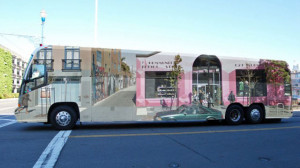Mission Local announced the
winning design of its tech bus contest yesterday with what might, at first glance, seem like a fairly innocuous proposal. Artist and Mission resident Elinor Diamond’s winning submission imagines a bus wrapped with a life-sized Google Street View image of the Mission’s Community Thrift Store, including a sidelong view of the Clarion Alley Mural Project (CAMP) — locations beloved by locals and internationals alike. Diamond’s design, perhaps inadvertantly, further underscores tensions around the contest, with CAMP artists up in arms after they explicitly refused to participate in the contest and objected to the use of their work in this context. In response to the announcement of the winning design, core CAMP organizer Megan Wilson publicly posted emails from CAMP artists articulating their objections to the contest.
Last October, Mission Local, an online news outlet specific to San Francisco’s Mission District, announced its unofficial contest, challenging artists to create designs to decorate the white commuter buses that shuttle tech workers between San Francisco and Silicon Valley. A cash prize of $500, supplied by an anonymous donor, was offered for the winning design, to be selected by the Mission Local editorial staff. The initial contest announcement was straightforward: “If you live or work in the Mission, you’re no stranger to the buses run by Google, Facebook, Apple, Yahoo, and Genentech… Don’t they look like big canvases just waiting to be painted on?” Contestants were simply encouraged to make the buses “beautiful,” with submissions due by the end of December. Judging by the entries posted online, some artists approached the buses as directed, proposing largely decorative designs, while others saw the contest as an opportunity to offer cultural critique about what the buses have come to represent.
And then things got complicated.
Over the last year, these plain white shuttle buses have become potent symbols for the rapidly growing technology sector, widespread gentrification and the shifting Bay Area landscape, as longstanding community members, nonprofit organizations and local businesses have been displaced by rising rents. A number of community organizations, many spurred by the Occupy movement, have banded together to address this inequity, several specific to the Mission, including: Eviction Free San Francisco, Our Mission NO Eviction, and Causa Justa::Just Cause, among others. Online the Anti-Eviction Mapping Project gives visual form to the issues.
For some, however, the tech-company buses represent a degree of environmental consciousness — some Genentech buses bear stickers that say, “This bus removes 120 cars from your commute everyday.” For others, the buses are the most visible icons of encroaching technology; after all, most tech companies are situated far outside of the city.




